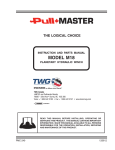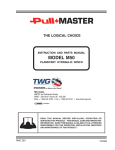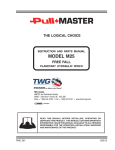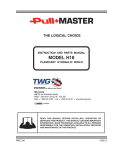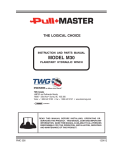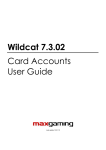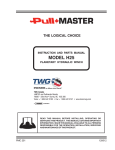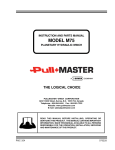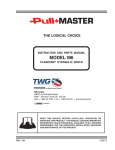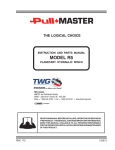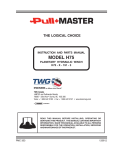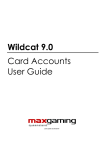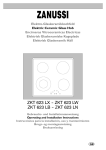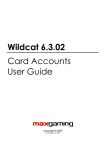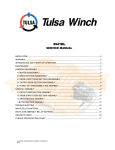Download Model M18 Free Fall
Transcript
THE LOGICAL CHOICE INSTRUCTION AND PART MANUAL MODEL M18 FREE FALL PLANETARY HYDRAULIC WINCH TWG Canada LANTEC and Pullmaster Brands 19350 – 22nd Ave • Surrey, BC V3S 3S6 Voice: + 1 604-547-2100 • Fax: + 1 604-547-2147 • www.team-twg.com READ THIS MANUAL BEFORE INSTALLING, OPERATING OR SERVICING THIS PRODUCT. THIS MANUAL CONTAINS IMPORTANT INFORMATION. MAKE THIS MANUAL AVAILABLE TO ALL PERSONS RESPONSIBLE FOR THE OPERATION, INSTALLATION, SERVICING AND MAINTENANCE OF THIS PRODUCT. PMC 373 120612 Effective 2011/10/01 SUPERSEDES ALL PRIOR WARRANTIES LIMITED WARR ANTY 50130-0 Seller warrants that each article (whether Gear Drive Products, Brake Products and/or Winch Products, all of which are covered hereunder) sold under this order shall at the time of shipment (i) conform to applicable specifications, and (ii) be free from defects in material and workmanship during normal and ordinary use and service (the "Warranty"). Buyer's exclusive remedy and Seller's sole obligation under this Warranty shall be, at Seller's option, to repair or replace any article or part thereof which has proven to be defective, or to refund the purchase price of such article or part thereof. Buyer acknowledges that Buyer is knowledgeable concerning the articles covered by this Warranty and sold in connection therewith which are being purchased, that Buyer has reviewed this Warranty and that the remedies provided hereunder are adequate and acceptable to Buyer. This Warranty shall expire one (1) year from the date the article is first shipped by Seller. Notice of claimed breach of this Warranty must be given by Buyer to Seller within the applicable period. Such notice shall include an explanation of the claimed warranty defect and proof of date of purchase of the article or part thereof for which warranty coverage is sought. No allowances shall be made by Seller for any transportation, labor charges, parts, "in and out" costs, adjustments or repairs, or any other work, unless such items are authorized in writing and in advance by Seller. Nor shall Seller have any obligation to repair or replace items which by their nature are expendable. If an article is claimed to be defective in material or workmanship, or not to conform to the applicable specifications, Seller will either examine the article at Buyer's site or issue shipping instructions for return to Seller. This Warranty shall not extend to any articles or parts thereof which have been installed, used, or serviced otherwise than in conformity with Seller's applicable specifications, manuals, bulletins, or instructions, or which shall have been subjected to improper installation, operation, or usage, misapplication, neglect, incorrect installation, overloading, or employment for other than normal and ordinary use and service. This Warranty shall not apply to any article which has been repaired, altered or disassembled, or assembled by personnel other than those of Seller. This Warranty shall not apply to any article upon which repairs or alterations have been made (unless authorized in writing and in advance by Seller). This Warranty shall not apply to any articles or parts thereof furnished by Seller to Buyer's specifications and/or furnished by Buyer or acquired from others at Buyer's request. SELLER MAKES NO EXPRESS WARRANTIES AND NO IMPLIED WARRANTIES OF ANY KIND, OTHER THAN THE WARRANTY EXPRESSLY SET FORTH ABOVE. SUCH WARRANTY IS EXCLUSIVE AND IS MADE AND ACCEPTED IN LIEU OF ANY AND ALL OTHER WARRANTIES, EXPRESS OR IMPLIED, INCLUDING WITHOUT LIMITATION THE IMPLIED WARRANTIES OF MERCHANTABILITY AND FITNESS FOR A PARTICULAR PURPOSE. Buyer expressly agrees that Seller is not responsible to perform any work or investigation related in any way to torsional vibration issues and is not responsible for the detection or remedy of Natural Frequency Vibration of the mechanical system in which the unit is installed. Buyer acknowledges, understands and agrees that this Warranty does not cover failures of the unit which result in any manner from the operation of the machine or unit at vibration frequencies at or near the natural frequency vibration of the machine in such a way that damage may result. Buyer expressly agrees that Seller is not responsible for failure damage or accelerated wear caused by machine or ambient vibration. Further, Buyer acknowledges and agrees that Buyer is always solely responsible for determination and final approval of the “application factor” which may be used in Seller’s calculations and this application factor is 1.0 unless otherwise stated in Seller’s quotation specifications. The remedies for this Warranty shall be only those expressly set forth above, to the exclusion of any and all other remedies of whatsoever kind. The limited remedies set forth above shall be deemed exclusive, even though they may fail their essential purpose. No agreement varying or extending the foregoing Warranty, remedies, exclusions, or limitations shall be effective unless in writing signed by an executive officer of Seller and Buyer. This Warranty is non-transferable. If a party who had purchased articles from Buyer, or from persons in privity with Buyer, brings any action or proceeding against Seller for remedies other than those set forth in this Warranty, Buyer agrees to defend Seller against the claims asserted in such action or proceeding at Buyer’s expense, including the payment of attorneys’ fees and costs, and indemnify Seller and hold Seller harmless of, from and against all such claims, actions, proceedings or judgments therein. Buyer also agrees to defend and indemnify Seller of, from and against any loss, cost, damage, claim, debt or expenses, including attorneys’ fees, resulting from any claims by Buyer or third parties to property or injury to persons resulting from faulty installation, repair or modification of the article and misuse or negligent operation or use of the article, whether or not such damage to property or injury to persons may be caused by defective material, workmanship, or construction. ADVISORY: Winches and hoists are not approved for lifting or handling personnel or persons unless specifically approved in writing from Seller for the specific intended application. Under no circumstances shall Seller be liable (i) for any damage or loss to any property other than the warranted article or part thereof, or (ii) for any special, indirect, incidental, or consequential damage or loss, even though such expenses, damages, or losses may be foreseeable. The foregoing limitations on Seller's liability in the event of breach of warranty shall also be the absolute limit of Seller's liability in the event of Seller's negligence in manufacture, installation, or otherwise, with regard to the articles covered by this Warranty, and at the expiration of the Warranty period as above stated, all such liabilities shall terminate. Buyer’s purchase of any article(s) covered by this Warranty shall constitute acceptance of the terms and conditions hereof and shall be binding upon Buyer and Buyer’s representatives, heirs and assigns. The laws of the Province of British Columbia shall govern Buyer’s rights and responsibilities in regard to this Warranty and the transaction(s) subject thereto, and the Province of British Columbia shall be the exclusive forum and jurisdiction for any action or proceedings brought by Buyer in connection herewith or any dispute hereunder. If any of the terms and conditions contained within this Warranty are void, the remaining provisions thereof are and shall remain valid and enforceable. TABLE OF CONTENTS SAFETY RECOMMENDATIONS................................................................ 1 DECRIPTION OF THE MODEL M18 WITH FREE FALL............................ 2 EXPLANATION OF THE MODEL CODING ............................................... 4 OPTIONS..................................................................................................... 5 SPECIFICATIONS....................................................................................... 6 PERFORMANCE GRAPHS........................................................................ 7 TYPICAL HYDRAULIC CIRCUIT ............................................................ 8-9 RECOMMENDATIONS ........................................................................ 10-11 OPERATING INSTRUCTIONS ............................................................ 12-13 TROUBLE SHOOTING .........................................................................14-16 SERVICE INSTRUCTIONS....................................................................17-30 RECOMMENDED MAINTENANCE .......................................................... 31 PARTS REFERENCE # / PART # ........................................................ 32-33 ASSEMBLY DRAWING AND EXPLODED VIEW ................................ 35-36 INSTALLATION DRAWING ...................................................................... 37 APPENDIX A ............................................................................................ 39 APPENDIX B ............................................................................................ 40 APPENDIX C ............................................................................................ 41 APPENDIX D ............................................................................................ 42 BOLT TORQUE CHART .......................................................................... 43 PMC 373 111024 SAFETY RECOMMENDATIONS Definition: Caution indicates a potentially hazardous situation which, if not avoided may result in minor or moderate injury. DANGER FAILURE TO COMPLY WITH THE FOLLOWING SAFETY RECOMMENDATIONS AND LOCAL RULES AND REGULATIONS WILL RESULT IN PROPERTY DAMAGE, SEVERE INJURY OR DEATH. Definition: Warning indicates a potentially hazardous situation which, if not avoided could result in death or serious injury. Definition: Danger indicates a potentially hazardous situation which, if not avoided will result in death or serious injury. The planetary hydraulic winches are made for hoisting and lowering loads and to be operated by trained and professional personnel. They are not designed for operations involving lifting or moving personnel. The winches are powered by hydraulic power. The ropes / cables for hoisting operations are not supplied by PULLMASTER. The winches are always assembled in an application, they do not function as an independent machine and it is not allowed to use them as such. The winches are to be used within the specifications as listed in the manual under “SPECIFICATIONS”. Other use as foreseen in the functional description of the hydraulic winch is not allowed without written permission from PULLMASTER. 1. Do not install, operate or service winch before reading and understanding manufacturer's instructions. 2. The winch described herein is not designed for operations involving lifting or moving personnel. 3. Do not lift or carry loads over people. 18. Use only recommended hydraulic oil and gear lubricant. 19. Keep hydraulic system clean and free from contamination at all times. 20. Maintain winch and equipment in good operating condition. Perform scheduled maintenance regularly. 4. Do not exceed recommended operating pressure (psi) and operating volume (gpm). 21. Keep hands clear when winding wire rope onto the winch drum. 5. Do not jerk the winch. Always smoothly accelerate and decelerate load. 22. Do not use the wire rope as a ground for welding. 6. Do not operate a damaged, noisy or malfunctioning winch. 23. Rig the winch carefully. Ensure that the wire rope is properly anchored to the correct cable anchor slot at the cable drum. 7. Do not leave a load suspended for any extended period of time. 24. Do not lift a load with a twisted, kinked or damaged wire rope. 8. 25. Consult wire rope manufacturer for size, type and maintenance of wire rope.elen Never leave a suspended load unattended. 9. Winch should be maintained and operated by qualified personnel. 10. Inspect winch, rigging, mounting bolts and hoses before each shift. 11. Warm-up equipment before operating winch, particularly at low ambient temperatures. 12. Verify winch function by raising and lowering a full test load to a safe height before each shift. 13. Do not weld any part of the winch. 14. Verify gear lubrication and brake circulation supply and return before operating winch. 15. Be sure of equipment stability before operating winch. 16. Wear proper clothing to avoid entanglement in rotating machinery. 17. 26. Maintain five wraps of wire rope on the cable drum at all times. 27. In case of a power failure or breakdown leading to an unexpected stop of the hydraulic power circuit, stand clear of the area and the load being hoisted, take the necessary precautions to prevent access to area where the load is halted. 28. The noise level of the winch is 86 dBA measured on a distance of 1.00 meter, 1.60 meters high. The measuring equipment used was: Realistic #42-3019. 29. Clean up any oil spillage immediately. 30. Wear proper clothing and personal protection equipment such as, footwear, safety goggles and a hard hat. Read manual first. Always stand clear of the load. 373 REV.111024 PAGE 1 DESCRIPTION OF THE MODEL M18 WITH FREE FALL GENERAL DESCRIPTION: The PULLMASTER Model M18 with free fall is a planetary hydraulic winch having equal speed in both directions and the ability to lower a load FAST. The free fall option comes in two variations: emergency free fall, or controlled free fall. The main components of this unit are: jj ✛ ✛ ✛ ✛ ✛ ✛ ✛ ✛ ✛ ✛ ✛ Hydraulic gear motor Multi disc brake with static and dynamic function Over-running clutch Hydraulic gear motor Primary planet reduction Final planet reduction Brake housing Cable drum Free fall housing Free fall clutch assembly Metering pump assembly (for controlled free fall) FUNCTION IN FORWARD ROTATION (HOISTING): In forward rotation, the output torque and rpm of the hydraulic motor are transmitted to the sungear of the primary planet reduction. The output of the primary reduction is transferred to the final sungear, which is splined to the primary planet hub. The final planet assembly is locked in place by the free fall clutch and does not rotate, so the rotation is transmitted to the cable drum by the final drive planet gears. In forward rotation, or when a load is lifted, an over-running clutch, which connects the motor drive shaft to the automatic brake assembly, permits free rotation of the sungear, without effecting the brake. When the winch rotation is stopped, the load on the cable drum causes the over-running clutch to lock and the maximum load is held safely by the disc brake. FUNCTION IN REVERSE ROTATION (LOWERING): In reverse rotation, or when the winch is pressurized for lowering of a load, hydraulic pressure from the reverse side of the hydraulic motor is channelled to the brake piston, causing the brake piston to release the multi-disc brake against a number of brake springs. The over-running clutch, connecting the motor drive shaft to the brake assembly, locks, causing the brake discs to rotate between divider plates, which are engaged into the brake housing. If the load on the cable drum tends to effect the lowering speed, the resulting pressure drop in the brake piston causes friction between the brake discs and the divider plates. In this way, a completely smooth pay out speed can be achieved in a stepless operation by modulation of the winch control handle. When the control handle is returned to neutral position, rotation stops and the disc brake applies automatically. A hydraulic counterbalance valve or holding valve is not required for smooth and positive operation of the automatic brake. During lowering operations of the winch, the friction created by the brake discs results in heat. This heat is dissipated by the circulation of hydraulic fluid through the brake housing, supplied internally from the motor, or externally, depending on the brake code of the winch. For efficient cooling of the automatic brake, models with external circulation should be adjusted to supply 5 (US) gpm - 19 l/min. This flow must be returned directly to the reservoir with a permissible back pressure of 30 psi (2 bar). IMPORTANT: Under no circumstances must the pressure in the brake housing be permitted to exceed 30 psi (2 bar). Excessive pressure in the brake housing will damage the oil seal separating the brake housing from the drum interior. Damage to this seal will cause the drum to fill up with hydraulic fluid. WARNING PRIOR TO OPERATION OF THIS UNIT ALWAYS ENSURE COMPLIANCE WITH ANY NATIONAL OR LOCAL SAFETY CODES AND REGULATIONS REGARDING THE USE OF FREE FALL WINCHES. PAGE 2 373 REV.111024 DESCRIPTION OF THE MODEL M18 WITH FREE FALL CONTINUED EMERGENCY FREE FALL: The emergency free fall is used for a full release of a suspended load up to the maximum load capacity of the Model M18 planetary winch. Upon acitivating the emergency free fall function the load will drop and must be allowed to fall to its end travel without re-engagement. DANGER RE-ENGAGING FREE FALL CLUTCH WHILE LOAD IS DROPPING CAUSES SHOCK LOADS AND WILL LEAD TO CABLE FAILURE, PROPERTY DAMAGE, SEVERE INJURY OR DEATH. INTERLOCK HYDRAULIC CONTROL TO PREVENT RE-ENGAGING FREE FALL CLUTCH WHILE LOAD IS DROPPING. FUNCTION OF THE EMERGENCY FREE FALL: When the Model M18 planetary winch is actuated for emergency free fall, hydraulic pressure is channelled to the clutch piston, causing the clutch piston to press against a series of springs and release the multi-disc clutch. This effectively disconnects the cable drum from the gear train of the winch and any suspended load will drop. The minimum load required to establish the emergency free fall mode is 500 lb (227 kg). CONTROLLED FREE FALL: The controlled free fall offers positive down control of a load at selected speeds and may be controlled anywhere on the way down by modulating the volume to metering pump. The controlled free fall is not designed, nor intended to lower the maximum load in a controlled free fall mode. The permissible load is 30% of the maximum line pull capacity of the winch. Since the clutch release pressure of the controlled free fall varies in accordance with the size of the load, a metering pump is utilized to compensate for clutch release pressure variations. FUNCTION OF CONTROLLED FREE FALL: The controlled free fall has the same basic function as the emergency free fall with the addition of a metering pump which regulates the different clutch pressure requirements during a controlled free fall. When the controlled free fall is actuated, hydraulic pressure is channelled into the clutch piston, causing the clutch piston to press against a series of springs and release the multi-disc clutch. When the clutch has been released, the final planet assembly rotates with the cable drum, around a stationary sungear. A small hydraulic gear pump is splined to the final planet hub. This hydraulic pump displaces hydraulic oil flow out of the free fall control circuit to compensate for the difference in the clutch release pressure, which varies according to the actual lowering speed. The faster the load is lowered with the free fall control, the faster the planet hub will cause the pump to turn, increasing the displacement volume drawn out of the control circuit. When the free fall control is returned to neutral, the hydraulic pressure in the clutch piston is vented and the free fall clutch is re-engaged by spring pressure. COMBINED EMERGENCY AND CONTROLLED FREE FALL: The emergency and controlled free fall can be combined for installations where both of these options are required. Two separate controls must be used for this option and the operating criteria for both functions must be adhered to. IMPORTANT: Under no circumstances must the pressure in the free fall housing be permitted to exceed 10 psi (.7 bar). Excessive pressure will damage the main drum seals. Damage to these oil seals will cause oil to leak between drum flange of brake housing or free fall housing. 373 REV.111024 PAGE 3 EXPLANATION OF MODEL CODING M 18 X - XX - XX - XX X - X XXXX BASIC UNIT SERIES M = Equal speed in both directions SIZE OF UNIT REDUCTION RATIO Only used for non standard reduction ratios TYPE OF BRAKE -3 Automatic brake, clockwise drum rotation, internal circulation flow -4 Automatic brake, external brake release, clockwise drum rotation, internal circulation flow -5 Automatic brake, external brake release, counterclockwise drum rotation, internal circulation flow -6 Automatic brake, counterclockwise drum rotation, internal circulation flow -7 Automatic brake, clockwise drum rotation, external circulation flow -8 Automatic brake, external brake release, clockwise drum rotation, external circulation flow -9 Automatic brake, external brake release, counterclockwise drum rotation, external circulation flow -10 Automatic brake, counterclockwise drum rotation, external circulation flow HYDRAULIC MOTOR -101 COMMERCIAL M365 hydraulic motor, 2.25 inch gear section (Other gear sections for this motor are optional) DRUM SIZE -1 8 1/2 inch drum diameter X 15 1/2 inch flange diameter X 10 inch length - STANDARD (For other drum sizes refer to APPENDIX A) OPTIONS -C Controlled free fall -D Emergency free fall DESIGN REVISION SPECIFICATION NUMBER Describes features not identified by preceding codes NOTE: Clockwise and counterclockwise drum rotation is the direction of rotation for pulling or hoisting, established by looking at the hydraulic motor PAGE 4 373 REV.111024 OPTIONS COUNTERCLOCKWISE ROTATION: The drum rotation of the standard PULLMASTER Model M18 planetary winch with free fall is clockwise for hoisting when looking at the hydraulic motor of the winch. Drum rotation for counterclockwise hoisting direction is available as an option. EXTERNAL BRAKE RELEASE: PULLMASTER planetary winches can be supplied with an external brake release which permits release of the automatic disc brake from an external pressure source. . DANGER FAILURE TO PROPERLY VENT EXTERNAL BRAKE RELEASE PORT WILL TRAP BRAKE PRESSURE AND ALLOW THE LOAD TO DROP, CAUSING PROPERTY DAMAGE, SEVERE INJURY OR DEATH. WINCHES SUPPLIED WITH EXTERNAL RELEASE OPTION MUST BE CONNECTED ACCORDING TO TYPICAL HYDRAULIC CIRCUIT. CABLE DRUM SIZES: Aside from the standard drum sizes listed in APPENDIX A, the PULLMASTER Model M18 planetary winch with free fall can be supplied with optional drums to accommodate large wire rope storage capacity. DRUM GROOVING: Cable drums for the PULLMASTER Model M18 planetary winch with free fall can be grooved. Where this option is a requirement, it is necessary to state the size of wire rope which is to be used with the winch. OPTIONAL GEAR SECTION FOR THE HYDRAULIC MOTOR: The performance of the standard PULLMASTER Model M18 planetary winch with free fall may be changed by using a different displacement motor. (Contact the factory for performance information.) HYDRAULIC MOTORS FOR HIGH PRESSURE HYDRAULIC SYSTEMS: The operating pressure of the PULLMASTER Model M18 planetary winch with free fall is limited to 2300 psi (159 bar). For hydraulic systems operating with a higher range of hydraulic pressure, the winch can be supplied with a hydraulic piston motor, which will provide for the same basic performance in terms of line pull and line speed capacity. (Contact the factory for this requirement.) The PULLMASTER WINCH CORPORATION will consider other options for quantity requirements. 373 REV.111024 PAGE 5 SPECIFICATIONS Performance specifications are based on standard hydraulic motor, gear ratio and cable drum with 3/4 inch diameter wire rope. For other cable drums refer to APPENDIX A. For other reductions or motors, refer to supplement inside back cover. Performance specifications for winches supplied with optional motors are provided in attached supplement. CABLE DRUM DIMENSIONS (STANDARD DRUM): Barrel diameter Flange diameter Barrel length 8.50 in 15.50 in 10.00 in 216 mm 394 mm 254 mm 494 ft 332 ft 310 ft 239 ft 170 ft 113 ft 151 m 101 m 94 m 73 m 52 m 34 m 2300 psi 159 bar MAXIMUM OPERATING VOLUME: 76 (US) gpm 288 l/min MINIMUM OPERATING VOLUME: 20 (US) gpm 76 l/min 83,250 lb-in 9,406 Nm Hoisting 50.5 rpm CABLE STORAGE CAPACITY: (Size of wire rope) 7/16 in 1/2 in 9/16 in 5/8 in 3/4 in 7/8 in MAXIMUM OPERATING PRESSURE: DRUM TORQUE AT MAXIMUM PRESSURE: DRUM RPM AT MAXIMUM PRESSURE: HOISTING LINE PULL AT MAXIMUM PRESSURE: Bare drum Full drum 18,000 lb 11,288 lb MAXIMUM ALLOWABLE LINE PUL WHEN USING CONTROLLED FREE FALL: Bare Drum 5400 lb Full Drum 3387 lb HOISTING LINE SPEED AT MAXIMUM VOLUME: Bare drum Full drum PERMISSIBLE SYSTEM BACK PRESSURE AT MOTOR RETURN PORT: PERMISSIBLE PRESSURE AT CIRCULATION SUPPLY PORT: Brake Housing Free fall Housing LUBRICATING OIL: PAGE 6 122 fpm 195 fpm 80.1 kN 50.2 kN 24 kN 15.1 kN 37 m/min 59 m/min 65 psi 4.5 bar 30 psi 10 psi 2 bar 0.7 bar Refer to RECOMMENDATIONS for viscosity and instructions. Refer to APPENDIX A for oil volume required. 373 REV.111024 PERFORMANCE GRAPHS PG-M18-B MAXIMUM ALLOWABLE LINE PULL WHEN USING CONTROLED FREE FALL Bare drum 5400 lb 24 kN Full drum 3387 lb 15.1 kN LINE PULL VS. OIL PRESSURE LINE PULL - kN 13.3 26.7 40.0 53.4 66.7 80.1 172 2000 138 M RU ED R BA UM 1500 L L FU DR 103 1000 69 500 34 0 OIL PRESSURE - bar OIL PRESSURE - psi 0 2500 0 0 3000 6000 9000 12000 15000 18000 LINE PULL - lb LINE SPEED VS. OIL VOLUME LINE SPEED - m/min 0 6 12 18 24 30 37 43 49 55 58 303 70 265 UM UM 60 E AR LL DR FU DR 227 B 50 189 40 152 30 114 20 76 10 38 0 OIL VOLUME - l/min OIL VOLUME - (US)gpm 80 0 0 20 40 60 80 100 120 140 160 180 191 LINE SPEED - fpm Performance graphs are based on standard hydraulic motor, gear ratio and cable drum with 3/4 inch diameter wire rope. 373 REV.111024 PAGE 7 TYPICAL HYDRAULIC CIRCUIT HC-M18-101-xD EMERGENCY FREE FALL: DANGER RE-ENGAGING FREE FALL CLUTCH WHILE LOAD IS DROPPING CAUSES SHOCK LOADS AND WILL LEAD TO CABLE FAILURE, PROPERTY DAMAGE, SEVER INJURY OR DEATH. INTERLOCK HYDRAULIC CONTROL TO PREVENT RE-ENGAGING FREE FALL CLUTCH WHILE LOAD IS DROPPING. PAGE 8 373 REV.111024 TYPICAL HYDRAULIC CIRCUIT CONTROLLED FREE FALL: 373 REV.111024 HC-M18-101-xC PAGE 9 RECOMMENDATIONS HYDRAULIC FLUID: The hydraulic fluid selected for use with PULLMASTER planetary winches should be a high grade, petroleum based fluid, with rust, oxidation and wear resistance. Fluid cleanliness and operating viscosity are critical to winch reliability, efficiency and service life. For optimum performance, the recommended viscosity range at operating temperature is 81 - 167 SUS (16 - 36 CS). For extreme operating conditions of short duration, the maximum viscosity range of 58 - 4635 SUS (10 1000 CS) should not be exceeded. For optimum performance, the winch recommended hydraulic fluid temperature operating range is 80 - 150F (27 - 66 C). For extreme operating conditions of short duration, the maximum temperature range of -5 - 180F (-21 - 82 C) should not be exceeded. LUBRICATION: The winch gear train requires oil bath lubrication. The winch is shipped from the factory without lubricating oil. IMPORTANT: ADD LUBRICATING OIL BEFORE RUNNING WINCH. Refer to INSTALLATION DIMENSIONS for location of lubricating oil fill port. Refer to APPENDIX A for quantity of oil required. For normal operating temperature use SAE 90 lubricating oil. For temperatures beyond normal operating range, consult lubricating oil supplier or factory. HYDRAULIC PUMP: For maximum performance of the PULLMASTER planetary winch, the hydraulic pump must supply the maximum flow of hydraulic fluid at the hydraulic pressure stated in SPECIFICATIONS. HYDRAULIC CONTROL VALVE: The standard control valve used for operation of the PULLMASTER planetary winch must have a four-way, spring return to neutral feature, which provides for open flow from the pressure ports of the winch to the reservoir in neutral position of the control (motor spool). It is important to point out that good speed control, especially when lowering a load, depends on the "metering" characteristics of the control valve. The better the oil flow is "metered" the better will be the speed control. PAGE 10 HYDRAULIC PRESSURE RELIEF: The hydraulic circuit for the PULLMASTER planetary winch requires a pressure relief set at the operating pressure (see SPECIFICATIONS). Usually, a pressure relief is part of the hydraulic control valve. Where this is not the case, a separate pressure relief valve must be installed and set at the recommended maximum pressure. HYDRAULIC RESERVOIR: It is recommended that the hydraulic reservoir has sufficient capacity to provide good heat dissipation in order to prevent over-heating of the hydraulic fluid. The hydraulic reservoir should be made from clean and scale-free material to prevent contamination of the hydraulic fluid. In order to prevent air from being mixed with the hydraulic fluid, the reservoir should have an over-flow baffle separating the return lines from the suction line and all return lines should enter the reservoir below the fluid level. The reservoir should be mounted close to and above the hydraulic pump in a location which provides for free air circulation around the reservoir. HYDRAULIC HOSES: The following hydraulic hoses are recommended for maximum efficiency of the PULLMASTER Model M18 planetary winch with free fall: Pressure lines: Circulation return line: Circulation supply line: Free fall release line: Equivalent to SAE 100R10-24 Equivalent to SAE 100R4-12 Equivalent to SAE 100R6-6 Equivalent to SAE 100R3-4 It is recommended that a larger size of hydraulic hose is installed where the pressure lines or the circulation lines are excessively long. HYDRAULIC FILTER: Hydraulic filter recommendations for the hydraulic circuit of the PULLMASTER planetary winch, based on a return line filter, are given as follows: Average Atmosphere: Dusty Atmosphere: 10 microns 5 microns In order to prevent accidental stoppage of the return line flow, the oil filter should have a by-pass feature. 373 REV.111024 RECOMMENDATIONS EMERGENCY FREE FALL CONTROL VALVE: The emergency free fall requires a two position, three-way valve. The clutch release of the winch must be open to the reservoir when the emergency free fall function is not activated and must pressurize the free fall clutch release port when the free fall control valve is activated. CONTROLLED FREE FALL CONTROL VALVE: For positive speed control, the valve used for the controlled free fall must be a “spring return”, two position selector valve, which has good metering characteristics and on which the pressure port is open to the reservoir when the controlled free fall is not operating. 373 REV.111024 CONTINUED PRESSURE GAUGE: To monitor free fall release port pressure install a 1000 psi (69 bar) pressure gauge between the free fall control valve and the release port. IMPORTANT: The circulation return lines must go direct to reservoir. Pressure in the free fall housing must not be permitted to exceed 10 psi (.7 bar). USE OF AN E STOP: (FOR EUROPEAN MACHINERY DIRECTIVE APPLICATIONS) The use of an E stop (emergency) is mandatory in the controls circuit. The E stop is to be placed in the operator’s control panel. The E stop must be designed and placed in line with EN 60204 and EN 418. PAGE 11 OPERATING INSTRUCTIONS DANGER FAILURE TO FOLLOW OPERATING INSTRUCTIONS WILL RESULT IN PROPERTY DAMAGE, SEVERE INJURY OR DEATH. After the PULLMASTER planetary winch has been installed in accordance with the INSTALLATION INSTRUCTIONS, the wire rope can be fastened to the cable drum. IMPORTANT: The wire rope is not part of the winch and is not covered by this manual. Refer to the wire rope manufacturer's handling, inspection and maintenance recommendations to avoid potential accidents. 1) The cable drum of the PULLMASTER planetary winch has two cable anchor slots, one for clockwise and one for counterclockwise hoisting. Standard rotation for hoisting is clockwise when looking at the hydraulic motor of the unit. It is critical to select the cable anchor slot which will permit winding of the wire rope on the drum in the correct direction of rotation. If the wire rope is wound on the cable drum in the wrong direction of rotation, the winch will have no braking capacity. Each winch is shipped from the factory with a label on the drum indicating the correct cable anchor slot. WIRE ROPE INSTALLATION Clockwise hoisting winch shown. (Use cable anchor slot on opposite side of drum for counterclockwise hoisting winch.) Feed the wire rope through the cable anchor slot. Loop rope back into slot as shown. Insert cable anchor into slot and pull rope tight to wedge rope in slot. SI1013-18FF 2) On wire rope installation, care must be taken that the wire rope is wrapped completely around the cable anchor and properly pulled into the cable anchor slot in the cable drum. The cable drum requires 5 wraps of wire rope for safety. 3) The winch operation is controlled by a single control valve lever which has a forward, a reverse and a neutral position. Speed control in either direction is obtained by modulation of the control valve lever. Maximum line speed in either direction is obtained when the control valve lever is moved as far as it can go. The disc brake of the winch will come on automatically when the winch control lever is returned to neutral. 4) Always warm up equipment prior to operating winch, particularly in low ambient temperature. Circulate hydraulic oil through the winch control valve for several minutes to warm the hydraulic system. To prime the winch with warm oil, operate the winch at slow speed, forward and reverse, several times. 5) Prevent corrosion damage to winch interior. If not used regularly, run winch up and down at least once every two weeks. 6) To ensure proper winch installation and function, raise and lower a full test load to a safe height before using winch for regular operation at the start of each shift. If, after a new installation, the winch does not function properly, refer to the TROUBLESHOOTING section of this manual. PAGE 12 373 REV.111024 OPERATING INSTRUCTIONS CONTINUED EMERGENCY FREE FALL: To actuate the emergency free fall, push the emergency free fall control to disconnect the cable drum from the gear train of the winch. The load (minimum 500 lb - 227 kg) will drop. The speed of the free fall will depend on the size of the load on the wire rope. DANGER RE-ENGAGING FREE FALL CLUTCH WHILE LOAD IS DROPPING CAUSES SHOCK LOADS AND WILL LEAD TO CABLE FAILURE, PROPERTY DAMAGE, SEVER INJURY OR DEATH. INTERLOCK HYDRAULIC CONTROL TO PREVENT RE-ENGAGING FREE FALL CLUTCH WHILE LOAD IS DROPPING. CONTROLLED FREE FALL: To operate the controlled free fall, open the free fall control lever gradually to obtain smooth acceleration of the lowering speed of the winch. The lowering speed is in direct proportion with the movement of the free fall control lever. To decelerate or slow down the load, slowly return the control lever back to it’s neutral position. Sudden stops of an accelerating load and erratic operation of the free fall control lever should be avoided. For better modulation of the free fall control, a long handle should be used on the free fall control valve. IMPORTANT: The controlled free fall is not designed nor intended to lower the maximum load in a controlled freefall. The permissible load of the PULLMASTER Model M18 controlled free fall operation is 30% of the maximum line pull capacity of the winch. If, after a new installation, the winch does not function properly, refer to the TROUBLESHOOTING section of this manual. 373 REV.111024 PAGE 13 TROUBLE SHOOTING GENERAL: In most cases, when the hydraulic winch does not perform satisfactorily, the cause of malfunction is found somewhere in the hydraulic circuit. Before the winch is removed from its mounting and disassembled, all of the hydraulic circuit components should be checked for proper function. IMPORTANT: The hydraulic oil volume relates to the line speed or rpm of the winch. Therefore, if the winch does not produce the specified maximum rated line speed or drum rpm, a loss of hydraulic flow somewhere in the hydraulic circuit system can be analysed. If this condition exists, install a flow meter into the hydraulic circuit to check the volume supplied to the pressure port of the hydraulic winch motor when the winch control is completely opened. The flow meter should indicate the maximum operating volume. If this test indicates a loss of hydraulic flow, check the hydraulic pump, the relief valve and the control valve. If the pump is driven by V-belts, check for belt slippage. The hydraulic pressure relates to the line pull or lifting capacity of the winch. If the winch will not lift the specified maximum line pull, install a pressure gauge into the pressure line leading to the hoisting port on the hydraulic winch motor. Stall the winch to prevent rotation of the drum and then open the control valve. Check the hydraulic pressure reading of the installed pressure gauge. If the pressure reads below the specified maximum operating pressure, look for trouble in the hydraulic pump, the relief valve and the control valve. If the pump is driven by V-belts, check for belt slippage. When checking oil pressure and volume in the hydraulic circuit, make certain that the hydraulic reservoir is filled to the top level and the hydraulic pump is running at maximum operating rpm. Only if the hydraulic system has been checked and found to be in order, use the following indications for probable causes of failure in the winch: PROBABLE CAUSE FAILURE Winch will not produce line pull at maximum pressure as listed in SPECIFICATIONS. a) b) c) d) e) f) Winch will not produce line speed at maximum volume as listed in SPECIFICATIONS. a) b) c) d) Winch will not reverse. a) b) c) d) e) PAGE 14 Winch is mounted to an uneven surface. (See INSTALLATION INSTRUCTIONS.) Cable sheaves or block purchase operated with the winch are not turning freely. Damage or wear in the hydraulic motor. Excessive back pressure in the hydraulic system. Relief valve may be set too low. (See SPECIFICATIONS for maximum operating pressure.) Clutch release valve may be in release position. Winch is mounted to an uneven surface. (See INSTALLATION INSTRUCTIONS.) Cable sheaves or block purchase operated with the winch are not turning freely. Damage or wear in the hydraulic motor. Excessive back pressure in the hydraulic circuit. Leakage out of the brake piston prevents the brake from being released against the brake springs. This is caused by damaged O-ring seals on the brake piston. The O-ring seals, on the brake release channel between the motor adaptor and the brake housing is damaged. If this failure occurs there will be substantial leakage from between the motor adaptor and brake housing. Insufficient hydraulic pressure. (See SPECIFICATIONS for minimum operating pressure.) Winch is mounted to an uneven surface. (See INSTALLATION INSTRUCTIONS.) Hydraulic pressure is not reaching the brake piston (plugged brake release orifice in the brake housing). 373 REV.111024 TROUBLESHOOTING PROBABLE CAUSE FAILURE Brake will not hold. CONTINUED a) b) c) d) e) f) g) h) Brake plates or divider plates have been damaged by contamination in the hydraulic fluid, or lack of circulation flow in the brake housing. Brake piston is seized in the brake housing because of contamination in the hydraulic fluid. Excessive back pressure in the return line causes the brake to be released. Control valve has incorrect spool, which traps hydraulic pressure in the brake piston when the control valve handle is returned to neutral position. For proper function of the automatic brake, both pressure ports of the winch must be open to the reservoir in neutral position of the control valve. Hydraulic pressure is trapped in the clutch piston, preventing total engagement. This is caused by using an incorrect control valve. The free fall control valve must leave the free fall release port open to reservoir when not activated. Wire rope is fastened to the incorrect cable anchor slot. Sprag clutch is damaged or surfaces where sprag clutch engages on motor drive shaft or brake hub are worn or indented. Winch supplied with external brake release option is not plumbed per TYPICAL HYDRAULIC CIRCUIT. Failure to vent external brake release port to reservoir may trap pressure and cause winch brake to slip. Brake vibrates when powering down a load. a) Pump does not supply sufficient flow. Pump rpm must be maintained at normal operating speed when a load is lowered. b) Brake is running too hot. This is caused by insufficient circulation flow. To check the circulation, observe the flow of oil from the circulation return line of the winch (approx. 5 (US) gpm - 19 l/min when the winch is reversed). c) Control valve for the winch operation has poor ‘metering’ characteristics. d) Damaged brake plates or divider plates. e) The over-running clutch, which connects the motor shaft with the brake assembly, is damaged. f) Air mixed with hydraulic oil (foamy oil). Free fall clutch cannot be disengaged. a) Insufficient pressure or flow supplied to free fall release port (refer to TYPICAL HYDRAULIC CIRCUIT). b) O-ring seals in clutch piston are damaged. c) Insufficient load on the wire rope. A minimum of 500 lb (227 kg) on a standard -1 drum is required to drop a load in free fall. Refer to the SERVICE INSTRUCTIONS if it becomes necessary to disassemble the Model M18 winch with free fall. 373 REV.111024 PAGE 15 TROUBLESHOOTING FAILURE CONTINUED PROBABLE CAUSE Free fall cannot be controlled. a) Emergency free fall is non-controllable. b) Piping circuit or control valve is incorrect. Check hydraulic circuit. c) Control valve used has poor metering characteristics. The control valve should have a flow capacity of 3-6 gpm maximum. If a large volume control valve is used, it may not provide good metering of the hydraulic oil, resulting in poor speed control. d) Hydraulic metering pump, installed in the end housing, is damaged. Oil leaks. a) Oil leaks from the motor flange are caused by a damaged O-ring seal on the motor flange. b) Oil leaks occurring between the cable drum flange and brake housing are caused by excessive pressure in the brake housing. Excessive pressure in the brake housing will damage oil seal, item 607, which separates the brake housing from the drum interior. c) Oil leaks occurring between the cable drum flange and free fall housing are caused by excessive pressure in the free fall housing. Excessive pressure in the free fall housing will damage oil seal, item 105. Maximum allowable back pressure in the free fall housing is 10 psi (0.7 bar). Check for restrictions in circulation return line (must go directly to reservoir). d) Oil leaking out of the free fall housing on either side of the spring retainer is caused by a damaged O-ring seal, item 213. e) Oil leaking out of the end cap indicates a damaged O-ring, item 241. Refer to the SERVICE INSTRUCTIONS if it becomes necessary to disassemble the Model M18 winch with free fall. PAGE 16 373 REV.111024 SERVICE INSTRUCTIONS GENERAL: Before attempting disassembly of the PULLMASTER Model M18 planetary winch with free fall, the following instructions for disassembly and reassembly should be read and understood: It is suggested that all expendable parts, such as O-rings and oil seals, are not reused on reassembly. It is therefore important to have a seal kit ( Part No.24434), providing the hydraulic gear motor has to be serviced, a seal kit ( Part No. 23139) on hand before the unit is taken apart. NOTE: Backup washers may be included with seal kit. Install with oil seals as per instructions. If not present in seal kit, the oil seals supplied do not require backup washers. A clean working area is of prime importance, similar to conditions used for service work on any other hydraulic component. All parts, as they are removed from the winch assembly, should be inspected for wear and damage. Worn or damaged parts must be replaced. Thoroughly clean parts before reassembly. Do not use solvent to clean the brake friction plates. During reassembly, lubricate all O-rings and oil seals with grease before installation. In the following service instructions, reference to parts is made by numbers and shown on the applicable group drawings. DISASSEMBLY For the majority of required service or repair work, disassembly is required only on the brake housing of the PULLMASTER Model M18 planetary winch with free fall. There are no special tools needed for the service or repair work and no adjustments or calibrations are necessary. Proceed with the disassembly as follows: 373 REV.111024 PAGE 17 SERVICE INSTRUCTIONS CONTINUED 1) DISASSEMBLY OF HYDRAULIC GEAR MOTOR ASSEMBLY: If the analysed service or repair work requires access to the interior of the brake housing, the hydraulic motor should not be disassembled. In this case, the hydraulic motor should be removed together with the motor adaptor as a complete assembly. If a problem has been analysed to be in the hydraulic motor, proceed with the disassembly as follows: 1.1) Remove the four hex capscrews, item 951, together with the lockwashers, item 953, from the motor assembly. IMPORTANT: Failure to exercise care when removing the motor port end cover or gear housing could permanently damage the machined surfaces of these motor components. Take care not to damage machined surfaces of motor components at disassembly. 1.2) Remove (pry loose if necessary) port end cover, item 870, together with two bushings, item 875. Two dowel pins, item 865, which are hollow for the capscrews to go through, will stay in either the port end cover or in the gear housing, item 861. 1.3) Remove gear set, item 881, which consists of two gears which are a matched set. 1.4) As the gears are removed, so is a thrust plate, item 885, two end seals, item 887, two side seals, item 891, and a backup seal, item 897. Discard end, side and backup seals. 1.5) Remove gear housing, item 861, together with gasket seals, item 869, and the remaining thrust plate with its end, side and backup seals. Discard the gasket, end, side and backup seals. 865 897 887 881 869 861 875 951 800 959 955 805 953 802 870 807 809 891 885 929 194 805 806 PAGE 18 HYDRAULIC MOTOR 373 REV.111024 SERVICE INSTRUCTIONS CONTINUED 950 * 1 SUB ASSEMBLY MOTOR 800 802 806 807 809 861 865 869 870 875 881 885 887 891 897 929 951 953 955 959 21952 1 * * * * * * * * 25795 25779 25780 21992 25782 25794 25774 25775 25776 25787 1 4 2 1 2 1 2 4 4 2 * * 25793 25784 25585 25031 4 4 2 2 MOTOR ADAPTOR SHUTTLE CIRCULATION VALVE / PIPE PLUG 1/4 18 NPT PIPE ADAPTOR / PIPE PLUG CAPLAG 1/8 NPT GEAR HOUSING DOWEL PIN SPACER SEAL GASKET PORT END COVER BUSHING GEAR SET THRUST PLATE SEAL END CHANNEL SEAL SIDE CHANNEL SEAL BACK UP PIPE PLUG 1/8 NPT CAPSCREW HX HEAD 3/4 10NC X 6.00 GR8 WASHER FLAT PLASTIC CAPLUG SAE #20 ORB DAEMAR T 17 PIPE PLUG 1/4 NPT SOC STEEL,AIRWAY #5409 * REFER TO APPENDIX D End, side, backup and gasket seals in the hydraulic motor assembly are not part of the winch seal kit. The seal kit for the hydraulic motor can be ordered from the factory under Part No. 23139. All parts of the hydraulic motor, with the exception of the motor adaptor, item 800, and the port end cover, item 870, are standard parts of the COMMERCIAL M365 hydraulic motor, having a 2.25 inch gear section. All of these parts can be ordered from COMMERCIAL INTERTECH dealers in Canada, the United States and in most overseas areas. If there is no COMMERCIAL INTERTECH representation, all parts for the hydraulic motor can be ordered from the factory. REMOVAL OF HYDRAULIC MOTOR ASSEMBLY: If disassembly of the hydraulic motor is not necessary, proceed as follows: a) Remove the eight hex head capscrews, item 821, with lockwashers, item 823, from the motor adaptor, item 800. Since the brake springs, item 752, apply pressure against the inside of the motor adaptor, it is recommended that the hex capscrews are unscrewed, one turn at a time, until the spring pressure has been released. The complete motor assembly, including the motor adaptor, can now be removed from the brake housing assembly. b) Remove and discard three O-rings, item 801, and O-ring, item 707. (O-rings, item 801, seal the pressure transfer hole for the automatic brake release and are situated on the flange of the brake housing.) 373 REV.111024 PAGE 19 SERVICE INSTRUCTIONS CONTINUED 2) DISASSEMBLY OF BRAKE HOUSING ASSEMBLY: 2.1) After the motor assembly has been removed, all parts of the brake assembly are accessible. Remove 10 brake springs, item 752. Thoroughly examine springs for damage and measure overall length. Overall spring length should be 2.27 inch. If any spring measures less than 2.21 inch, replace all springs as a set. 2.2) Pull the brake piston, item 750, out of the brake housing using two 5/8-11NC bolts screwed into the two puller holes in the piston and discard O-rings, item 751 and item 753. 2.3) Pull the motor drive shaft, item 730, and complete brake hub assembly from the brake housing. 2.4) Disassemble brake hub assembly by removing circlip, item 719, from motor drive shaft. Remove motor drive shaft from brake hub, item 720. Remove sprag clutch aligners, items 722 and 724, and sprag clutch, item 723, from brake hub. DANGER MINOR SURFACE DEFECTS WHERE THE SPRAG CLUTCH ENGAGES THE MOTOR DRIVE SHAFT AND BRAKE HUB, WILL RESULT IN BRAKE FAILURE AND ALLOW THE LOAD TO DROP, CAUSING PROPERTY DAMAGE, SEVERE INJURY OR DEATH. THOROUGHLY INSPECT THESE AREAS AND, IF NECESSARY, REPLACE MOTOR DRIVESHAFT, SPRAG CLUTCH AND BRAKE HUB AS A SET. 727 731 730 724 720 723 722 719 PAGE 20 373 REV.111024 SERVICE INSTRUCTIONS CONTINUED 718 ** 1 SUB-ASSEMBLY BRAKE HUB 719 720 722 723 724 727 730 731 25336 21986 20455 25303 20421 25335 21322 25288 1 1 1 1 1 1 1 1 CIRCLIP ROTOR CLIP SH-187 BRAKE HUB SPRAG CLUTCH ALIGNER SPRAG CLUTCH BORG WARNER SPRAG CLUTCH ALIGNER RIGHT CIRCLIP ROTOR CLIP SH-196 MOTOR DRIVE SHAFT CIRCLIP ROTOR CLIP C-112 ** PART No. VARIES ACCORDING TO BRAKE CODE - REFER TO APPENDIX D 2.5) Thoroughly inspect motor drive shaft, item 730, and brake hub, item 720, particularly the surfaces where the sprag clutch, item 723, engages. If any indentation or surface damage is detected, replace brake hub, sprag clutch and motor drive shaft as a set. 2.6) Thoroughly examine the inner bores of the brake housing and the outer diameters of the brake piston for scoring caused by hydraulic fluid contamination. Minor surface damage may be repaired by polishing with a fine emery cloth. DANGER DAMAGED FRICTION OR DIVIDER PLATES WILL REDUCE BRAKING CAPACITY AND ALLOW THE LOAD TO DROP, CAUSING PROPERTY DAMAGE, SEVERE INJURY OR DEATH. SOLVENT MAY DAMAGE THE FRICTION PLATES. DO NOT USE SOLVENT TO CLEAN THE FRICTION PLATES. PERFORM THOROUGH INSPECTION AND, IF NECESSARY, REPLACE FRICTION AND DIVIDER PLATES AS A SET. 2.7) Remove six friction plates, item 715, and seven divider plates, item 713, and inspect for damage or wear. Plates should be flat and smooth. Plates should not show heat discoloration. Paper material on friction plates should be intact and grooved. If any damage is detected, replace friction and divider plates as a set. 373 REV.111024 PAGE 21 SERVICE INSTRUCTIONS CONTINUED 3) DISASSEMBLY OF FREE FALL ASSEMBLY: If a failure occurs in free fall section of the winch, proceed as follows: 3.1) Remove drain plug, item 121, from end cover, item 240, and drain lubricating oil from free fall housing and end cover. The oil will drain quicker if the filler plug, item 121, is removed from cable drum item 500. 3.2) In controlled free fall model winch includes metering pump at back of free fall end cover item 240. If a failure has occurred in metering pump, the pump can be removed without disassembling the rest of the free fall assembly. Before disassembly metering pump remove tube assembly, item 216 from end cover, item 240.To remove metering pump, item 242, unscrew four capscrews, item 197, and lockwashers, item 541. Remove and discard O-ring, item 241. The metering pump is not user serviceable, and must be replaced. 3.3) Remove 16 head capscrews, item 239, with lockwashers, item 237, and separate free fall clutch assembly from free fall housing, item 200. a IMPORTANT: Internal gear item 330, may come off of planet gears at this time. If this occurs, care must be taken to ensure the part does not slide out of ball bearing item215, and drop. 3.4) Remove internal gear, item 330. 3.5) 5a) Inspect hub stopper, item 126 for excessive wear. Replace if less than .50 inch thick. 5b) Remove metering pump connector, item 248. 5c) Inspect sungear stopper, item 344, for excessive wear. Replace if less than .22 inch thick. 3.6) Pull final planet assembly out of cable drum, item 500, and inspect for wear or damage. (Two capscrews, 5/8-11NC, can be screwed into two tapped pulling holes in planet hub to assist with removal of final planet hub assembly.) 3.7) Inspect three final planet gears, item 320, for damage or wear. If it is necessary to remove final planet gears, remove circlip, item 311, and press planet pin, item 310, out of planet hub, item 300. Inspect loose rollers, item 323, and two thrust washers, item 321, and replace if damaged. 3.8) Pull final sungear, item 340, out of cable drum, item 500. 3.9) Remove 8 socket head capscrews, item 207, along with lockwashers, item 217, from spring retainer, item 212. CAUTION: Since 38 springs apply pressure behind spring retainer, socket head capscrews should be loosened one turn at a time, until spring pressure has been relieved. 3.10) Pull spring retainer, item 212, out of free fall clutch housing, item 240 and free fall piston housing, item 250. Remove and discard O-ring, item 213, from spring retainer. 3.11) Remove 38 springs, item 232, from clutch piston, item 230. 3.12) Pull clutch piston, item 230, out of free fall clutch housing, item 240 and free fall piston housing, item 250. (Use two long 1/2-13NC capscrews screwed into piston to assist removal. Alternatively, compressed air may be carefully applied to free fall release port to assist removal of clutch piston.) 3.13) Remove and discard O-rings, items 231 from clutch piston, and 233 from free fall housing. PAGE 22 373 REV.111024 SERVICE INSTRUCTIONS CONTINUED 3.14) Check clutch piston outside diameters and inside diameters of free fall piston housing for surface scratches due to contamination resulting from particles in the hydraulic fluid. If there is any evidence of surface damage, polish with fine emery cloth. 3.15) Pull clutch connecting shaft, item 220, out of free fall clutch housing and free fall piston housing, along with two bearings, item 215. DANGER DAMAGED FRICTION OR DIVIDER PLATES WILL REDUCE BRAKING CAPACITY AND ALLOW THE LOAD TO DROP, CAUSING PROPERTY DAMAGE, SEVERE INJURY OR DEATH. SOLVENT MAY DAMAGE THE FRICTION PLATES. DO NOT USE SOLVENT TO CLEAN THE FRICTION PLATES. PERFORM THROUGH INSPECTION AND, IF NECESSARY, REPLACED FRICTION AND DIVIDER PLATES AS A SET. 3.16) Remove 11 friction plates, item 206, together with 12 divider plates, item 204, and inspect for damage or wear. Plates should be flat and smooth. Plates should not show heat discoloration. Paper material on friction plates should be intact and grooved. If any damage is detected, replace friction and divider plates as a set. 3.17) Remove clutch spacer, item 202. 373 REV.111024 PAGE 23 SERVICE INSTRUCTIONS CONTINUED 4) DISASSEMBLY OF FINAL PLANETARY DRIVE (item 299) If disassembly of Final Planetary Drive is required, proceed as follows: 4.1) 4.2) 4.3) 4.4) Remove Circlip, item 311 from Planet Pin, item 310. Press Planet Pin, item 310 out of Planet Hub, item 300. Remove Planet Gear, item 320, out of Planet Hub, item 300. Inspect Loose Rollers, item 323 and two Thrust Washers, item 321. Replace if necessary. 300 321 310 321 323 311 320 311 299 23580 1 SUB-ASSEMBLY FINAL DRIVE 300 310 311 320 321 323 23581 21940 25960 21937 25965 25308 1 3 6 3 6 66 PLANET HUB PLANET PIN CIRCLIP ROTOR CLIP SH-131 PLANET GEAR THRUST WASHER TORRINGTON # TRD 2233 LOOSE ROLLER 7/32 DIA X 1.50 PAGE 24 373 REV.111024 SERVICE INSTRUCTIONS CONTINUED 5) DISASSEMBLY OF PRIMARY PLANETARY DRIVE (item 399) If primary drive requires service or repair, proceed as follows: 5.1) Turn winch over to sit flat on free fall housing, item 200. Remove four hex capscrews, item 555, with lockwashers, item 553, from each side of both tie bars, item 556, and take the tie bars from the assembly. 5.2) Using a 1/2 inch capscrew, item 821, pull out access plug, item 734, out of the brake housing, item 700, and discard O-ring, item 735. 5.3) Remove eight hex capscrews, item 537, along with lockwashers, item 541, from bearing flange, item 530, by rotating brake housing until access hole is over top of them. The brake housing, together with the primary planet hub assembly, can now be lifted out of the cable drum, item 500. 5.4) Remove internal retaining ring, item 401, from inside of internal gear, item 430. The primary planet hub assembly may now be slid out of the internal gear and inspected for wear or damage. If the primary planet gears, item 420, need to be removed, take off circlip, item 411, from planet pin, item 410, and press the planet pin out of the primary planet hub, item 400. Remove the primary planet gear, item 420, together with loose rollers, item 423, and thrust washers, item 421. On reassembly, these thrust washers must be installed. 444 400 413 421 421 423 420 410 411 399 22003 1 SUB-ASSEMBLY PRIMARY DRIVE 400 410 411 413 420 421 423 444 21944 21966 25961 25962 21957 25964 25270 21962 1 3 3 3 3 6 60 1 PLANET HUB PLANET PIN CIRCLIP ROTOR CLIP C-81 CIRCLIP ROTOR CLIP SH-81 PLANET GEAR THRUST WASHER TORRINGTON # TRB 1423 LOOSE ROLLER 5/32 X 1.25 SUNGEAR STOPPER 373 REV.111024 PAGE 25 SERVICE INSTRUCTIONS CONTINUED 6) REMOVAL OF DRUM SEAL (item 105) 6.1) Remove primary sungear, item 440, from center of connecting shaft, item 600. 6.2) Take circlip, item 431, off the end of the connecting shaft and slide the internal gear, item 430, along with spacer, item 434, off of the connecting shaft spline. 6.3) The connecting shaft, item 600, may now be pulled out of the brake housing, and O-ring, item 601, discarded. Inspect needle bearing, item 603, and remove and replace if necessary. 6.4) To separate the bearing flange, item 530, and brake housing, item 700, use a standard bearing puller or insert two heel bars in the slot between the bearing flange and the brake housing and pry the brake housing out of the ball bearing, item 533. 6.5) Remove the internal circlip, item 535, to remove ball bearing, item 533. Remove and discard oil seal, item 531. 531 539 530 533 535 529 24433 1 SUB-ASSEMBLY BEARING FLANGE 530 531 533 535 539 22514 26359 25150 25153 25966 1 1 1 1 1 BEARING FLANGE OIL SEAL BALL BEARING 110 X 170 X 28 # 6022 CIRCLIP ROTOR CLIP HO-662 O RING -168 7-1/4"ID 3/32"CS 6.6) To separate the free fall housing, item 100, and cable drum, item 500, first remove the external circlip, item 513, off the end of the cable drum then insert two heel bars in the slot between the final drive housing and the cable drum and pry the cable drum out of the ball bearing, item 103. 6.7) Remove the internal circlip, item 109, to remove ball bearing, item 103. Remove and discard oil seal, item 105. The PULLMASTER Model M18 with free fall has now been completely disassembled. PAGE 26 373 REV.111024 SERVICE INSTRUCTIONS CONTINUED REASSEMBLY Thoroughly clean all parts. Use only new, well-greased O-rings and oil seals. Unless otherwise specified, torque fasteners per BOLT TORQUE CHART at back of manual. If the entire winch was disassembled, start by reassembling the free fall end first. 1) REASSEMBLY OF FREE FALL ASSEMBLY: Reassemble free fall end of winch as follows: 1.1) If free fall housing was removed, press in new oil seal item 105, and bearing item 103, if removed. Re-install retaining ring item 109. 1.2) Press free fall housing item 200, onto splined end of cable drum, and install circlip item 513. 1.3) Set free fall housing kit, item 240 and item 250, with opening facing up. 1.4) Install clutch connecting shaft item 220, into free fall housing kit. 1.5) Set clutch spacer item 202, into free fall housing kit, and place a divider plate item 204, against it, lining up teeth with those inside of free fall housing kit. DANGER INCORRECT ASSEMBLY OF THE FRICTION PLATE AND DIVIDER PLATE STACK WILL REDUCE BRAKING CAPACITY AND ALLOW THE LOAD TO DROP, CAUSING PROPERTY DAMAGE, SEVERE INJURY OR DEATH. REASSEMBLE PER INSTRUCTIONS. 1.6) 1.7) 1.8) 1.9) 1.10) 1.11) 1.12) 1.13) 1.14) Place brake plate item 206, against divider plate, lining up teeth onto teeth of clutch connecting shaft item 220. Alternate remaining divider and brake plates, finishing stack with a divider plate. Install new, well-greased O-rings item 231 and item 233, onto clutch piston item 230. Carefully press clutch piston item 230, into free fall housing kit, item 240 and item 250. If a hoist is available, piston can be supported using two 1/2 -13NC eyebolts. Place 38 springs item 232, into holes in clutch piston. Install two new, well-greased O-rings item 213, into grooves on flanges of spring retainer item 212. Fasten spring retainer to end cover using 8 socket head capscrews item 207, along with 8 high collar lockwashers, item 217. Fasten capscrews, one turn at a time, to compress 38 springs. Reassemble final planet hub assembly. Use grease to temporarily hold 22 loose rollers item 323, in bore of planet gear item 320. Position thrust washers item 321, on either side of planet gear. Press planet pin item 310, into final planet hub item 300, and retain with circlip item 311. Insert final planet hub assembly into free fall housing item 200. Ensure that final planet hub spline is fully engaged with cable drum item 500. Install final sungear item 340, through centre of three final planet gears and into cable drum item 500. 1.15) EMERGENCY FREE FALL: Install internal gear item 330, with sungear stopper item 248, over top of planet gears item 320. CONTROLLED FREE FALL: 15a) Insert metering pump connector item 248, with sungear stopper item 344, and planet hub stopper item 126, into final planet hub item 300. 15b) Install internal gear item 330, over top of planet gears item 320. 1.16) Install free fall housing kit, item 240 and item 250, and spring retainer assembly, into free fall housing and secure with 16 capscrews item 239 and lockwashers item 237. If controlled free fall model, metering pump is assembled and/or installed after brake housing and tie bars are re-installed. 373 REV.111024 PAGE 27 SERVICE INSTRUCTIONS CONTINUED 2) REASSEMBLY OF PRIMARY DRIVE: Reassemble primary drive as follows: 2.1) Reassemble primary planet hub assembly. Use grease to temporarily hold 20 loose rollers, item 423, in the bore of planet gear, item 420. Verify placement of sungear stopper, item 444. Position thrust washers, item 421, on either side of planet gear and press planet pin, item 410, into final planet hub, item 400. Retain with circlip, item 411. 2.2) Press new, well-greased oil seal, item 531, into bearing flange, item 530. Press ball bearing, item 533, into bearing flange and secure with retaining ring, item 534. 2.3) Press bearing flange assembly onto brake housing, item 700, and install new, well-greased O-ring, item 539. 2.4) Press new, well-greased oil seal, item 607, into bore in connecting shaft, item 600. If a backup washer, item 606, is included in seal kit, install it behind oil seal. 2.5) Install new, well-greased O-ring, item 601, onto connecting shaft and insert through bore of brake housing, item 700. Place spacer, item 434, onto shoulder of internal gear, item 430, and slide internal gear onto spline of connecting shaft. Fasten with circlip, item 431. 2.6) Insert primary sungear, item 440, between three primary planet gears, item 420, and insert sungear shaft into connecting shaft, engaging planet gears with internal gear. Fasten with retaining ring, item 401. 2.7) Insert final sungear, item 340, into cable drum and engage three planet gears, item 320. 2.8) Lower brake housing assembly onto cable drum while engaging spline of final sungear with primary planet hub, item 400. Line up mounting holes of bearing flange, item 530, with those in the cable drum. 2.9) Rotate brake housing to line up access hole to fasten bearing flange to cable drum using six capscrews, item 537, and lockwashers, item 541. 2.10) Install new, well-greased O-ring, item 735, into access plug, item 734. Install access plug into access hole inside brake housing. 2.11) Fasten two tie bars, item 556, using 16 capscrews, item 555, and lockwashers, item 553. 3) REPLACE METERING PUMP: Install metering pump onto winch as follows: 3.1) Insert metering pump shaft item 190, into free fall end cover and engage external spline with that of metering pump connector item 248. 3.2) Install new, well-greased O-ring item 241, onto metering pump adaptor. Insert metering pump into free fall housing opening, engaging spline of metering pump shaft. 3.3) Fasten with four head capscrews item 197, and lockwashers item 199. 4) REASSEMBLY OF BRAKE HOUSING ASSEMBLY: Reassemble brake housing assembly as follows: 4.1) Install sprag clutch, item 723, into bore of brake hub, item 720. Position sprag clutch aligners, item 722 and item 724, on either side of brake hub. Carefully slide motor drive shaft, item 730, into brake hub assembly and secure with circlip, item 727. Verify that circlips, item 719 and item 731, are installed on motor drive shaft. 4.2) Carefully slide motor drive shaft, item 730, with brake hub assembly, into connecting shaft until it engages spline of primary sungear, item 440. IMPORTANT: For proper brake function, verify that sprag clutch is installed correctly. When viewed from the motor end, the motor drive shaft of a clockwise hoisting winch must turn freely clockwise and lock in the counterclockwise direction. PAGE 28 373 REV.111024 SERVICE INSTRUCTIONS CONTINUED 4.3) Install brake spacer, item 712, into brake housing. DANGER INCORRECT ASSEMBLY OF THE FRICTION PLATE AND DIVIDER PLATE STACK WILL REDUCE BRAKING CAPACITY AND ALLOW THE LOAD TO DROP, CAUSING PROPERTY DAMAGE, SEVERE INJURY OR DEATH. REASSEMBLE PER INSTRUCTIONS 4.4) Starting and finishing with a divider plate, alternately install seven divider plates, item 713, and six friction plates, item 715. 4.5) Liberally grease O-ring, item 751, and O-ring, item 753, and install on brake piston, item 750. 4.6) Slide brake piston into the brake housing with holes for brake springs facing out of brake housing assembly. 4.7) Install 14 brake springs, item 752, in brake piston using hole pattern shown: LOCATION OF M18 BRAKE SPRINGS (TEN SPRINGS, SIXTEEN HOLES) SI1007-M18 4.8) Liberally grease three new O-rings, item 801, and install into the recesses on motor adaptor, item 800. Install new, well-greased O-ring, item 707, on flange of motor adaptor. 4.9) Slide hydraulic motor assembly onto splined end of motor drive shaft, item 730, and line up pressure transfer holes of brake housing and motor adaptor. Install eight capscrews, item 821, and lockwashers, item 823. Tighten one turn at a time to evenly compress springs. 373 REV.111024 PAGE 29 SERVICE INSTRUCTIONS CONTINUED 5) REASSEMBLY OF HYDRAULIC GEAR MOTOR: If the hydraulic motor was disassembled, the following procedure should be followed for reassembly: 5.1) Clean all parts thoroughly before reassembly and apply grease liberally to all seals. Use only new seals (seal kit Part No. 23139) for hydraulic motor. 5.2) Install two new end seals, item 887, and two new side seals, item 891, into openings in thrust plate, item 885. Install new backup seal, item 897, over top of side and end seals with tabs facing towards thrust plate. Place thrust plate assembly onto motor adaptor, item 800, with backup seal against motor adaptor. 5.3) Install gear set, item 881, into bushings, item 875. Gear with internal splines engages with motor drive shaft, item 730. 5.4) Install well-greased gasket seal, item 869, on each side of gear housing, item 861. Slide gear housing, together with gasket seals, onto motor adaptor, item 800, lined up on two dowel pins, item 865. Tap on tight using a soft headed hammer. 5.5) Install other thrust plate, complete with seals, on top of gear set with backup seal facing upwards. 5.6) Install port end cover, item 870, together with two bushings, item 875, onto the gear housing, lined up on two dowel pins, item 865. Tap on tight using a soft headed hammer. Install and lightly torque four hex capscrews, item 951, and lockwashers, item 953, to approximately 50 ft-lb (70 Nm). 5.7) Plumb winch assembly to a hydraulic supply and torque motor capscrews according to the following procedure: - Ensure that circulation supply flow is being supplied to the brake housing. - Run the winch , with no load, in the hoisting direction at reduced speed (approximately 30% of maximum hydraulic volume). - With winch running, evenly tighten four capscrews, item 951, to 450 ft-lb (610 Nm). - Test motor operation by running winch at full speed in both directions. DANGER LIFTING A LOAD WITH A NEWLY SERVICED WINCH WILL ENABLE AN INSTALLATION OR SERVICE PROBLEM TO GO UNDETECTED AND ALLOW THE LOAD TO DROP CAUSING PROPERTY DAMAGE, SEVERE INJURY OR DEATH. TO ENSURE PROPER REINSTALLATION, REFER TO PROCEDURES AND TESTS DESCRIBED IN "INSTALLATION" AND "OPERATING INSTRUCTIONS". PAGE 30 373 REV.111024 RECOMMENDED MAINTENANCE Winch gear train lubricating oil should be changed after the initial six months or 50 hours of operation, whichever comes first. Lubricating oil should then be changed every 12 months or 500 operating hours, whichever comes first. Hydraulic system fluid should be changed at least once every 12 months. For optimum performance over an extended period of time, the following preventive maintenance service should be done every 12 months or 500 operating hours (whichever comes first): 1) Disconnect all hydraulic hoses and remove the winch from its mounting. 2) Disassemble the winch as per instructions. 3) Discard and replace all O-rings and oil seals. 4) Clean all parts and inspect for wear and damage as per instructions. Replace worn or damaged parts as required. 5) Reassemble the winch as per instructions. 6) Follow INSTALLATION and OPERATING INSTRUCTIONS when returning winch to its mounting. When ordering parts for the PULLMASTER Model M18 free fall planetary winch, always quote the complete model and serial number of the unit. MODEL NO. _______________ SERIAL NO. _______________ PULLMASTER WINCH CORPORATION reserves the right to change specifications and the design of PULLMASTER planetary winches at any time without prior notice and without incurring any obligations. 373 REV.111024 PAGE 31 PARTS REFERENCE ITEM NO. QTY. PART NO. 103 105 109 121 126 130 156 171 185 188 188A 189 190 194 197 200 201 202 204 206 207 208 212 213 215 216 217 218 219 220 221 230 231 232 233 237 239 240 241 242 248 250 252 254 256 1 1 1 2 1 1 1 1 1 1 1 1 1 25150 26359 25153 25032 ** 4 1 1 1 12 11 8 2 1 2 1 1 8 1 1 1 1 1 1 38 1 24 16 1 1 1 1 1 1 2 8 ** 26277 ** 25395 ** ** ** ** ** ** 25264 * 25481 22527 26100 26101 25852 25347 22512 25340 25575 ** 25298 ** ** 22516 25095 22510 26102 20761 26103 25014 26887 24325 25083 ** ** 24328 25488 25695 25259 DESCRIPTION BALL BEARING 110 X 170 X 28 # 6022 OIL SEAL CIRCLIP ROTOR CLIP HO-662 PIPE PLUG 1/2 NPT PLANET HUB STOPPER PLASTIC CAPLUG 1/2 NPT COVER PLATE PLASTIC CAPLUG 1/4 NPT PIPE TEE 1/4 NPT PLUG - SAE #12 X 1/4 NPT PLUG - SAE #12 CIRCLIP ANDERTON # A1000 - 0100 METERING PUMP SHAFT PIPE PLUG 1/4 NPT CAPSCREW - HEX HEAD 3/8 - 16NC X 1.00 FREEFALL HOUSING PIPE PLUG 1 NPT CLUTCH SPACER DIVIDER PLATE FRICTION PLATE CAPSCREW - SOCKET HEAD 3/8 - 16NC X 1.25 PLASTIC CAPLUG 1 NPT SPRING RETAINER O RING -281 15"ID 1/8"CS BALL BEARING 160 X 200 X 20 # 61832 HOSE ASSEMBY LOCKWASHER 3/8" HIGH COLLAR TUBE CONNECTOR TUBE 90º ELBOW CLUTCH CONNECTING SHAFT BALL BEARING 100 X 150 X 24 # 6020 CLUTCH PISTON O RING -90 DURO -458 14-1/2"ID 1/4"CS SPRING FREEFALL O RING -90 DURO -459 15"ID 1/4"CS LOCKWASHER 1/2" CAPSCREW - HEX HEAD 1/2 -13NC X 6.50 FREEFALL CLUTCH HOUSING O RING -045 4"ID 1/16"CS SUB-ASSY METERING PUMP METERING PUMP CONNECTOR FREEFALL PISTON HOUSING O RING -280 14"ID 1/8"CS O RING 13mm ID 2mm CS CAPSCREW - HEX HEAD 3/8 -16NC X 1.50 * These parts and quantities vary according to drum code. Refer to APPENDIX B ** These parts and quantities vary according to type of freefall. Refer to APPENDIX C Refer to PAGE 35 for ASSEMBLY DRAWING. PAGE 32 373 REV.111024 PARTS REFERENCE ITEM NO. QTY. 299 330 340 343 344 399 401 430 431 434 440 500 502 513 529 537 541 551 553 554 555 556 600 601 603 606 607 700 707 712 713 715 718 734 735 750 751 752 753 801 805 821 950 1 1 1 1 1 1 1 1 1 1 1 1 1 1 1 8 20 * * 2 16 2 1 1 1 1 1 1 1 1 7 6 1 1 1 1 1 10 1 3 3 8 1 PART NO. ** 22513 * 25963 ** 22003 22093 21943 25971 21988 21963 * 21960 25489 24433 25118 25037 25139 25359 * * * 21987 25341 25334 21086 25345 * 25033 21985 25953 25952 22132 21984 25967 21936 25968 20413 25969 25127 25040 25081 22005 DESCRIPTION SUB-ASSY FINAL DRIVE INTERNAL GEAR FINAL SUNGEAR CIRCLIP ROTOR CLIP SH-181 SUNGEAR STOPPER SUB-ASSY PRIMARY DRIVE RETAINING RING INT 5/32 X 5/32 X 6.0 OD INTERNAL GEAR CIRCLIP ROTOR CLIP SH-255 SPACER SUNGEAR CABLE DRUM CABLE ANCHOR CIRCLIP ROTOR CLIP SH-425 SUB-ASSY BEARING FLANGE CAPSCREW - HEX HEAD 3/8 - 16NC X 1.25 LOCKWASHER 3/8" CAPSCREW - HEX HEAD 5/8 - 11NC X 1.50 LOCKWASHER 5/8" BASE PLATE CAPSCREW TIE BAR CONNECTING SHAFT O RING -239 3-5/8"ID 1/8"CS NEEDLE BEARING TORRINGTON # B2812 BACK-UP WASHER OIL SEAL BRAKE HOUSING O RING -271 9-1/4"ID 1/8"CS BRAKE SPACER DIVIDER PLATE FRICTION PLATE SUB-ASSY BRAKE HUB PLUG O RING -117 13/16"ID 3/32"CS PISTON O RING -90 DURO -372 8 3/4"ID 3/16 CS BRAKE SPRING O RING -90 DURO -373 9"ID 3/16" CS O RING -90 DURO -013 7/16"ID 1/16"CS PIPE PLUG 1/8 NPT CAPSCREW - HEX HEAD 1/2 - 13NC X 1.50 SUB-ASSEMBLY MOTOR * These parts and quantities vary according to drum code. Refer to APPENDIX B ** These parts and quantities vary according to type of freefall. Refer to APPENDIX C Refer to PAGE 35 for ASSEMBLY DRAWING. 373 REV.111024 PAGE 33 ASSEMBLY DRAWING REFER TO PAGE 26 239 237 250 230 233 232 212 213 215 248 000 344 109 103 513 105 502 434 535 533 529 541 537 531 712 715 700 751 707 718 REFER TO PAGE 21 256 752 541 440 240 606 130 607 197 950 242 REFER TO PAGE 18 219 188 185 219 241 750 221 821 556 555 713 216 753 121 823 204 218 254 252 202 206 220 208 231 190 213 126 299 200 330 551 553 554 340 343 500 401 399 430 431 600 539 601 603 REFER TO PAGE 24 THESE ITEMS ARE SUB-ASSEMBLIES. (FOR PARTS BREAK DOWN REFER TO PAGE NUMBERS SHOWN) 373 REV.111024 REFER TO PAGE 25 CROSS-SECTION DRAWING REFERENCE LESS PARTS THAN ARE ACTUALLY PRESENT IN AN ASSEMBLY. REFER EXPLODED VIEW FOR OTHER PARTS. PAGE 35 EXPLODED VIEW 344 189 299 340 343 330 213 130 197 188A 256 541 194 213 212 212 217 207 221 541 242 232 220 216 218 188 219 185 121 171 239 237 202 206 240 208 200 204 105 230 506 233 502 500 121 126 401 399 700 190 431 440 430 434 256 601 606 551 553 109 751 753 950 821 529 201 554 513 373 REV.111024 231 213 215 248 541 600 603 607 750 707 823 103 555 553 553 551 555 735 734 712 715 713 718 801 752 554 PAGE 36 INSTALLATION DIMENSIONS IN3245 373 REV.111024 PAGE 37 INSTALLATION DIMENSIONS Dimensions in inches [Dimensions in milimeters] DRUM CODE A B C D E F G H J K M N P R S T V W Y Z -1 8.5 15.5 10.0 8.3 17.9 19.1 15.4 9.430 39.1 [216] [394] [254] [210] [454] [486] [392] [239.52] [994] 3.0 10.13 12.9 18.4 13.500 17.8 5.8 35.4 11.6 12.63 18.1 [76] [257.2] [329] [468] [342.90] [451] [147] [899] [296] [321] [460] -3 8.5 20.0 16.0 8.4 20.8 18.5 22.0 18.500 43.9 1.8 10.75 13.5 23.3 17.250 21.6 6.3 41.6 12.3 13.25 18.0 [216] [508] [406] [214] [527] [470] [559] [469.90] [1116] [44] [273.1] [342] [591] [438.15] [546] [159] [1057] [312] [337] [457] Dimensions in inches [Dimensions in millimeters] HYDRAULIC MOTORS COMMERCIAL M365 GEAR MOTORS MOTOR CODE GEAR WIDTH -42 COMMERCIAL "WM" TWO-SPEED GEAR MOTORS I L MOTOR CODE 2.50 [63.5] 8.1 [205] 2.5 [64] -143 2.50 + 2.50 [63.5 + 63.5] -101 2.25 [57.2] 7.8 [198] 2.5 [64] -148 2.50 + 2.50 [63.5 + 63.5] -102 2.00 [50.8] 7.6 [192] 2.5 [64] -128 1.75 [44.5] 7.3 [186] 2.5 [64] -161 1.00 [25.4] 6.6 [168] 2.5 [64] -162 1.5 [38.1] 7.1 [180] 2.5 [64] -163 1.25 [31.2] 6.9 [173] 2.5 [64] PAGE 38 MOTOR PORT SIZE SAE 4 BOLT FLANGE 1.50 inch Code 61 GEAR WIDTH MOTOR PORT SIZE SAE 4 BOLT FLANGE 1.25 inch Code 61 I L PORT X' PORT Y' 14.7 [373] 2.9 [74] DRAIN LOW SPEED 14.7 [373] 2.9 [74] HIGH DRAIN SPEED 373 REV.111024 APPENDIX A DRUM CODE CABLE DRUM SIZES WIRE ROPE STORAGE INCHES (MILLIMETERS) FEET (METERS) BARREL FLANGE LENGTH LINE PULL AT MAXIMUM PRESSURE* LINE SPEED AT MAXIMUM VOLUME* POUNDS (KILONEWTONS) FEET/MINUTE (METERS/MINUTE) 7/8 in 3/4 in 5/8 in BARE DRUM -1 8.5 (216) 15.5 (394) 10.0 (254) 113 (34) 170 (52) 239 (73) -3 8.5 (216) 20.0 (508) 16.0 (406) 372 (113) 500 (152) 747 (228) FULL DRUM LUBRICATING OIL VOLUME REQUIRED U.S. GALLONS (LITERS) BARE DRUM FULL DRUM 18000 11288 (80.1) (50.2) 122 (37) 195 (59) 1.3 (4.9) 18000 (80.1) 122 (37) 255 (78) 2.1 (7.9) 8649 (38.5) * Performance specifications are based on standard hydraulic motor with 3/4 inch diameter rope. 373 REV.111024 PAGE 39 APPENDIX B DRUM CODE -3 -1 ITEM NO. PART DESCRIPTION PART NUMBER 200 PAGE 40 FREEFALL HOUSING QTY PART NUMBER QTY 22511 1 22963 1 340 FINAL SUNGEAR 21964 1 22050 1 500 CABLE DRUM 21953 1 22398 1 551 CAPSCREW 25139 10 25139 26 553 5/8 LOCKWASHER 25359 26 25359 42 554 BASE PLATE 21926 2 22046 2 555 CAPSCREW 25797 16 25419 16 556 TIE BAR 21954 2 22045 2 700 BRAKE HOUSING 21989 1 22053 1 373 REV.111024 APPENDIX C ITEM NO. DESCRIPTION 126 PLANET HUB STOPPER 156 COVER PLATE 185 TYPE OF FREE FALL CONTROLLED ( C ) EMERGENCY ( D ) 22521 N/A N/A 22694 PIPE TEE 1/4NPT 26116 N/A 188 PLUG SAE #12 x 1/4NPT 22522 N/A 188A PLUG SAE #12 26107 N/A 189 CIRCLIP 25262 N/A 190 METERING PUMP SHAFT 22518 N/A 194 PIPE PLUG 1/4NPT 25031 ( 3 ) 25031 ( 4 ) 216 HOSE ASSEMBLY 26610 N/A 218 TUBE CONNECTOR 26171 N/A 219 TUBE 90 ELBOW 26118 N/A 242 SUB-ASSY METERING PUMP SEE APPENDIX D N/A 248 METERING PUMP CONNECTOR 22517 N/A 248 STOPPER N/A 22697 299 SUB-ASSY FINAL DRIVE 23580 22002 344 SUNGEAR STOPPER 19036 N/A 373 REV.111024 PAGE 41 APPENDIX D BRAKE CODE -3 ITEM NO. -4 -5 -6 -7 -8 -9 - 10 PART DESCRIPTION PART NUMBERS 242 METERING PUMP SUB-ASSY 24313 24313 24312 24312 24313 24313 24312 24312 718 BRAKE HUB SUB-ASSY 22132 22132 22133 22133 22132 22132 22133 22133 802 SHUTTLE N/A 20849 20849 N/A N/A 20849 20849 N/A 806 CIRCULATION VALVE 20456 20456 20456 20456 N/A N/A N/A N/A 806 1/4-18 NPT PIPE PLUG N/A N/A N/A N/A 25031 25031 25031 25031 807 1/8-27 NPT PIPE PLUG 25040 N/A N/A 25040 25040 N/A N/A 25040 807 1/8-27 NPT PIPE ADAPTOR N/A 25622 25622 N/A N/A 25622 25622 N/A 809 1/8 NPT CAPLUG N/A 25374 25374 N/A N/A 25374 25374 N/A 929 3/8 NPT CAPLUG N/A N/A N/A N/A 26276 26276 26276 26276 929 3/8-18 NPT PIPE PLUG 25085 25085 25085 25085 N/A N/A N/A N/A 950 MOTOR SUB-ASSY 22032 22290 22291 22033 22034 22305 22306 22035 PAGE 42 373 REV.111024 BOLT TORQUE CHART BOLT DIAMETER Inches TORQUE lb-ft TORQUE Nm 1/4 9 18 32 50 75 110 150 265 420 640 800 1000 1200 1500 12 24 43 68 102 149 203 359 569 868 1085 1356 1627 2034 5/16 3/8 7/16 1/2 9/16 5/8 3/4 7/8 1 1 1/8 1 1/4 1 3/8 1 1/2 NOTE: Unless otherwise specified, torque bolts per above chart. 373 REV.111024 PAGE 43















































